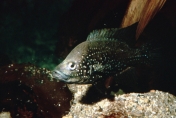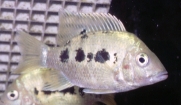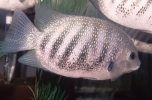| Identify your Cichlid |
| Identify your Cichlid |
The beginning cichlid keeper is often faced with the daunting fact that there are so many species of cichlids and yet so much about their care and behavior that depends on knowing more-or-less which species of cichlid you have. Sometimes this information is forgotten, or sometimes it was never provided by the fish store selling the fish. Ocassionally the information provided by fish stores is inaccurate, particularly when it comes to the spelling of a cichlid's name. This can make it very hard to look up information in books or online.
The purpose of this page is to help the beginner on the road to identifying the type of cichlid he or she has or is interested in. This is not a strict "scientific key" in which following the statements will inevitably lead you to a correct determination. Such a key requires that a person know a lot of information and it is that information that is so often lacking. Rather this is a rough-and-ready guide that will hopefully prove useful for identifying the most common cichlids.
I divide cichlids into several large groups, based mostly on my experience with how these fish are treated by hobbyists. These groups do NOT reflect either the true biological relationships of these fishes (their phylogenetic relationships), nor do they tell you anything about keeping the fish. They merely refer to the rough physical appearance of the fish and serve as an aide to identifying the fish. You can then seek out additional information, once you know roughly which group of fish yours is in.
The groups are as follows:
- Neotropical (New World)
- African
- Madagascar
- Asian
The first step in identifying your cichlid is to figure out which one of these four groups it is in. We start by eliminating the last two.


Paretroplus maculosus Paratilapia polleni (male) Madagascar cichlids are rare and expensive and it is unlikely you have acquired one of these by accident. The fish in this group include the genera Paretroplus and Paratilapia, amongst others. The only ones that you are likely to encounter in are Paratilapia polleni or Paratilapia bleekeri. P. polleni is the one with the little spots, P. bleekeri has larger spots.


Ptychochromis sp. gold Etroplus suratensis The Asian cichlids consist of a few oddball fish. There are three species of fish in India and Sri Lanka, all in the genus Etroplus. Etroplus maculatus is relatively common and is sold as the orange chromide. It is a small fish, usually an inch to two inches long, and a great fish to have and breed. Etroplus suratensis is sometimes called the green chromide. It grows much larger (6 to 8 inches at least) and is occassionally available in the hobby. The third species, Etroplus canarensis, is very rare in the hobby -- call me if you see one for sale!
There are a few species of cichlids found in the Middle East, technically Asia, such as Saratherodon galilaeus but these are closely related to African cichlids and are best dealt with there.
So, if your fish isn't a Madagascan cichlid and it isn't an Etroplus from near India, it must be either from the New World or Africa.
Keep in mind that with 1500 species, almost any non-technical rule is going to have a ton of exceptions, but here are some guidelines.
Neotropical cichlids can be divided into several kinds:
- Cichlasoma-like cichlids
- Pike cichlids
- Apistogramma-like cichlids
- Eartheater cichlids
African cichlids can be divided into
- West African dwarf cichlids
- Lake Malawi cichlids
- Lake Tanganyikan cichlids
- Lake Victoria cichlids
- Others cichlids
To decide which of these you have, consider the following questions:
Is your fish small (less than 2 inches), medium (2 inches to 10 inches), large (greater than 10 inches)?
--> The size I am referring to is the adult size. All cichlids start out small, but some don't get large. Of course you may not know the answer to this, but it is one thing to ask at the store when buying a fish. If your fish is small, often called a "dwarf" cichlid, it is likely either an Apistogramma-like cichlid (from South America), a West African dwarf, or one of the shell-dwellers from Lake Tanganyika. The Apistogramma-like fish includes the genus Apistogramma. Most Malawi fish are medium-sized, with some notable exceptions. Lake Tanganyika fish are highly variable in size.
Is your fish tall-bodied or long and thin?
--> Most of the taller-bodied cichlids are Cichlasoma-type cichlids. These include fish like the discus, angelfish and many fish now in the genus Theraps, Vieja, etc. A lot of these fish have roughly the same body shape as a sunfish. Many of the Malawi fish are longer and thinner. The pike cichlids are long and thin, but usually lack the intense coloration of fish from Lake Malawi. CAUTION: there are lots of exceptions.
Is the fish blue?
--> Many of the fish from Lake Malawi are blue. There are few cichlids from elsewhere that are really blue.
Are the colors very saturated and the markings sharp and distinct, or are the colors more subtle and the edges of the markings diffuse?
--> Many of the fish from Malawi have very distinct markings, i.e. there may be a black bar on a blue body, or a black stripe on a yellow body, but the edges of the stripe are sharply demarked. The markings on cichlasoma-like fish are often more diffuse and may change minute by minute. I realize this is a vast generalization but I have found it a very useful question when trying to identify someone else's fish.
Is it a mouthbrooder?
--> Many of the African cichlids are mouthbrooders, but only a few of the Neotropical cichlids are mouthbrooders.
Does it appear to be a Cichlasoma-like fish but the guy at the fish store said it was African?
--> It may be Tilapia buttikoferi, a West African cichlid that looks a lot like a Neotropical cichlid.
Was it called a Peacock cichlid?
--> Peacock cichlids are from Lake Malawi and are found in the genus Aulonacara.
Was it called a jewel cichlid?
--> Jewel cichlids are West African cichlids of the genus Hemichromis.
Was it called a red devil?
--> Red devil is the name given to several cichlasoma-like fish from Central America. You may have either a true Red devil (Amphilophus labiatum) or a midas cichlid (Amphilophus citrinellum).
Was it called a Haplochromis or a "Hap"?
These are African fish, often from Lake Victoria.
Was it called a green terror?
--> This name is often given to the Neotropical fish Aequidens rivulatus.
Was it called a red terror?
--> This name is often given to either of two Neotropical cichlids, one from Central America Cichlasoma urophthalmus , the other from South America, Cichlasoma festae.
I am still developing this page and I appreciate your comments on whether the "fish identification page" helped you identify your fish, and any suggestions for improvement. Mail Comments to me.
![[Go Back to Contents]](gifs/back.gif) |
![[Send email to Ron Coleman]](gifs/address.gif) |